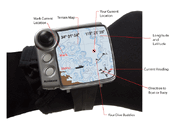I once took my Garmin E trex GPS u/w, It worked, but only down to a depth of 2'...
GPS, Radio's, all pretty much work by "line of sight" if there is something in the way, a signal can be weak, or no signal at all...a good example: you are in a car on the ground in NYC trying to get a 2-way radio signal with your buddy who is outside the city, it would be pretty hard to get a firm signal with all the buildings, but if you are in an open field the signal can travel from one device to the other with no interference... Another example: when aircraft are in flight they can pick up ATC (air traffic control) radio signals from hundreds of miles away, thats because when they are at (for ex) 35,000' there is no obstruction in the way to block signals from a tower that is 150 miles away etc... But, with the case of a GPS u/w the signal is hard to penetrate the water's surface do to reflection, and even if it could, there's still refraction that would screw up the signal.... there is nothing wrong with using a compuss, and fin kicks to get somewhere, and back tracking your route, say you start at a heading of 0 (or 360) degrees (North), go 100 fin kicks, turn left to a heading of 270 degrees (West), go 100 fin kicks, then turn 0 degrees (or 360) (North) and go 200 fin kicks, to get back to the starting point you would head 180 degrees (South) for 200 fin kicks, turn to a heading of 090 degrees (East) for 100 fin kicks, and make a final turn to 180 degrees (South) for 100 fin kicks, and now you are back at your starting point (of course be sure to calculate for current etc...), there are also other ways to determine distance, i.e. time, arm spans, laying a line (measured of course) etc...





